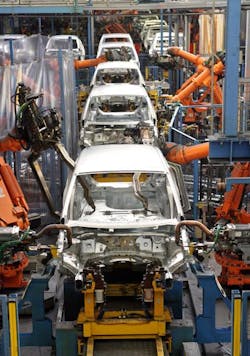Ford’s most recent endeavor in this area is experimentation with tree fibers (a substance more readily known as cellulose) for its woven materials (think seat covers again) as well as to replace a variety of plastic composites.
Basically, Ford’s biomaterials research team is working with forestry firm Weyerhaeuser to use cellulose fibers from trees to replace fiberglass and/or mineral reinforcements that go into making components such as armrests.
Ellen Lee, Ford's plastic research technical expert, said the automaker and Weyerhaeuser have been working together for three years dissecting how cellulosic fibers can be used in light vehicles, discerning along the way that such “tree fiber” has a high thermal stability, doesn't discolor and doesn't produce an odor.
[Tree fiber, by the way, is already being used to make clothing. Indeed, check out how Patagonia uses wood pulp-based fiber to make its goods – fiber gleaned from eucalyptus tree farms in South Africa.]
More important, Lee’s team found that such tree fiber-based components weigh about 10% less than fiberglass-based materials, can be produced 20% to 40% faster, and require less energy to be manufactured.
Thus Ford concludes such weight and process savings can enable equivalent or reduced component costs – hopefully contributing in some form to price savings for vehicle buyers when all is said and done."All of that's important because it opens the door for use of the material in a wide range of applications that could eventually add up to significant environmental benefits across our product line,” Lee (at right) said.
She also stressed that her team’s research indicates that cellulose material can not only be used in vehicle interiors but for exterior and under-the-hood applications as well – all because Weyerhaeuser's cellulose-based plastic composite materials meet the automaker's requirements for stiffness, durability and temperature resistance.
The other benefit is that the “raw material” is available in abundance and can be renewed fairly easily. Indeed, Weyerhaeuser alone oversees more than 20 million acres of sustainably managed and third-party certified forestland around the world and plants more trees than are harvested (no worries about supply shortages here!)
Tree fiber, of course, isn’t the only “sustainable material” Ford is experimenting with. Indeed, Ford is already using quite of few such materials in current production. For example:- The company’s new Fusion sedan uses the equivalent of about 42 recycled plastic bottles in its seat fabric and post-consumer recycled carpet in its cylinder head covers.
- The Fusion also contains the equivalent of slightly more than two pairs of average-sized American blue jeans as sound-dampening material
- Ford's entire North American lineup of vehicles contain soybean-based cushions and head restraints, while the plastic bins in its Flex crossover are partially made from wheat straw. Incidentally, using soybean-based cushions and head restraints saves the automaker from using about 5 million pounds of petroleum annually.
- Kenaf fiber – derived from a plant related to cotton and okra – is used in the door bolsters of Escape compact SUV.
- The equivalent of 25 recycled 20-ounce plastic bottles help make up the Escape's carpet
- The Focus Electric uses a wood-fiber-based material in its doors and recycled plastic bottles in its seat fabric.
Perhaps the biggest critical factor with all of these “sustainable materials” is that they offer Ford – and other vehicle makers as well – the opportunity to reduce costs across a wide range of areas; savings that will hopefully (as I stressed before) get transferred down the line to the vehicle buyer. If that happens, you’ll no doubt see usage of such “green” stuff only increase.



